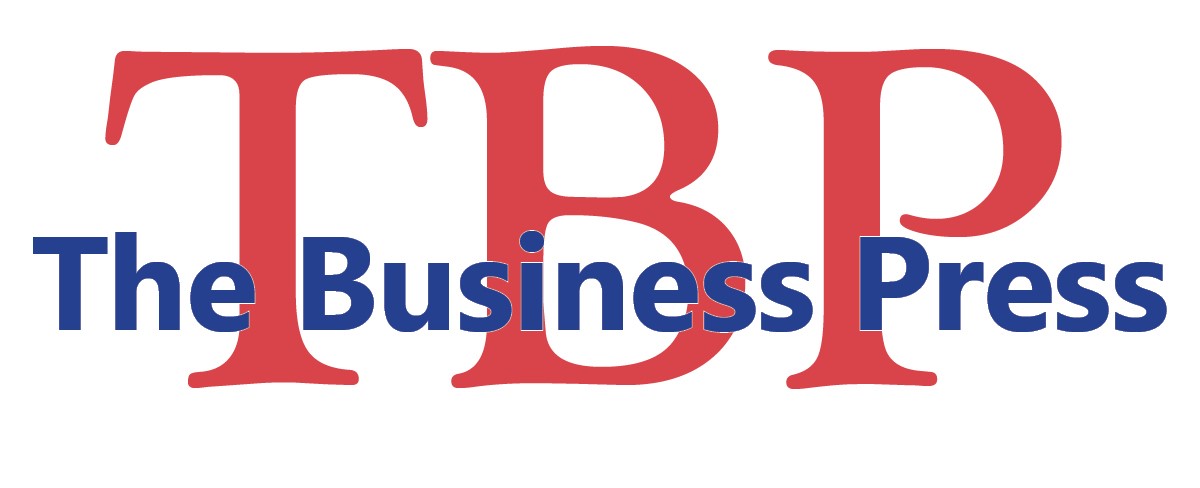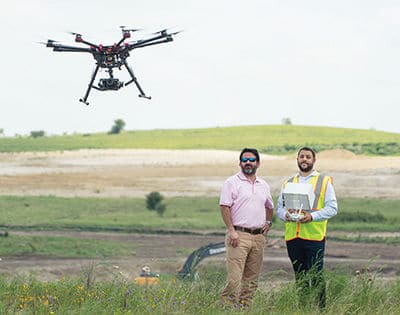UM Inspections LLC
UM Inspections is a surveying and inspection company, for infrastructure, property, right of ways and environmental projects.
817-935-8660
www.uminspections.com
By using drones to cut time and cost, while increasing accuracy and output, UM Inspections is revolutionizing surveying and inspection, particularly in the oil and gas industry.
Jonathan Kohn, founder and president/CEO of UMI, started the Fort Worth-based business in 2015 after he realized that there had to be a better way to map, measure and inspect than sending someone to a creek with a yardstick.
What he found was that drone technology could provide the types of measurements he was looking for cheaper and easier than the industry-standard laser scanner.
Kohn’s 17-year background in the oil and gas industry from landman to land manager to vice president of Balanced Energy, as well as his work with geographic information systems technology, has given him a unique perspective on how to incorporate unmanned aerial vehicles in the surveying and inspection process.
But, he knew he needed a business partner with more experience on the surveying and management side to help his company succeed. So, through a mutual friend, Kohn met
oil and gas man Ted Valdez.
Valdez and Kohn talk for more than three hours the first time they met, talking about data, technology, inspection, surveying, applications, innovation and more. Valdez is now the chief survey officer for UMI.
Valdez explained that unless companies in the industry can be cheaper, different or more efficient they aren’t getting business right now.
“Jonathan displayed that you can be cheaper, more efficient [and] possibly more accurate,” he said. “So that’s why [working with the drones] really appealed to me. I knew that this would be probably the future of the surveying industry.”
Valdez said surveying through UMI is typically 20 to 25 percent less than with a traditional survey company, depending on what services are needed.
UMI aims to cut down the current labor-intensive process of sending a crew of land men out to survey and map by using GIS and drone technologies to produce not only the orthomosaic picture – an image that has been corrected so it can be used to measure true distances like a map – but also a 3D point cloud and, finally, a 3D digital surface model.
“Most drone companies right now are using 12 MP [megapixel] sensors, [and] a good drone company [in the industry right now] is going to have a 24 MP camera,” Kohn said, adding that UMI uses either a 42 or 41.3 MP camera with its drones to help them get the most accurate and measurable images.
After using the combinations of technology to gather the data and information, UMI takes the data and applies “deep learning processing and analytics” to recreate information about the data and turn it into a 3D model accurate to less than one inch accuracies.
The standard in the industry now is primarily ground-based laser equipment.
Valdez said a ground scanner costs about $30,000. “I could buy several drones for that, or I could buy one drone that can do a square mile in an hour,” Kohn said, explaining that either deal is a better financial choice than the laser.
Kohn and Valdez said they’ve noticed a knee-jerk hesitation to utilizing the drone technology for oil and gas surveying, despite the cheaper cost and faster output.
“Even though oil and gas is probably the most technologically advanced industry in the planet as far as using math and deep basic science, … when it comes to adopting [new technology] they’re very soft,” Kohn said.
But, Valdez added, after seeing demonstrations they are more likely come around to the idea.
“Initially they were bumping heads but they’re starting to open up to it. Once we can actually go out there and show them what we can do it’s almost a no brainier,” he said. “We’re building with science and math and you can’t fake that.”
UMI is currently working with Republic Property Group’s developments including the Walsh project on the west side of Fort Worth.
“We’ve enjoyed working with UM Inspections and think their innovative use of drones is forward-thinking, helping lead the way for how technology is being used in the surveying and inspection industry,” said Tony Ruggeri, co-CEO of Republic Property Group.
Valdez said UMI was able to accumulate a vast amount of data for Republic in a short amount of time. “For the fine level survey of individual lots on the first 500 lots on the Walsh project, it would have taken over 400 survey crew hours to pick up the same data that we were able to acquire in a two-hour flight,” he said.
Kohn said they are also working on a roofing and solar inspection project with a solar company, as well as an emergency response project with an oil and gas company.
Ultimately, UMI hopes to be in a place where it can easily work on projects in five areas the technology is known for: detection, infrastructure inspections, surveying, risk management and environmental surveys. But for now, the company plans to focus on areas the management has experience in, such as detection, surveying and infrastructure inspections.
While UMI is focusing on its core three applications and services, the same five board members – Kohn, Valdez, CFO Ian Fay, COO Christopher Jenseth and Curtis Ewers with regulatory affairs – have been working on sister company EESO Systems, which is more hardware focused than service focused.
Additionally, the UMI advisory board – made up of Ken Wisian, Sam Hernandez and James Frelk – is also the EESO Systems advisory board, which works with Kohn on specific Department of Defense-related consulting projects.
“The advisory board is basically people that can leverage us or we can leverage them,” Kohn said. “And they’re more on the defense side because there’s a big interest in homeland security and critical infrastructure security.”
EESO is currently working with its DOD partners to help bring advanced robotics to first responders, specifically to the DFW Airport Police in this project, Kohn said.
“We are going to be doing a demo with them of a hybrid ground-air drone. So, it will be able to drive for eight hours on the ground, take off, fly for 15 minutes in the air,” Kohn said. “So, it gives it a very different scope of mission abilities that most drones don’t have right now.”
Valdez added that the companies are run by the same people but as UMI already dips into so many service areas it made sense to separate the service side and the product side of the business.
The 41.3 MP camera that UMI uses on some of the drones, for example, isn’t something that can be bought off the shelf, Kohn said. It comes from the company’s DOD contacts.
Through EESO, Kohn consults with Robotic Research – a defense contractor working with DOD and “three letter agencies within the DOD.”
“That’s kind of our secret sauce,” he said. “We’re still testing [and] we still haven’t released mapping done on that, but [Robotic Research] is the first company to purchase these cameras from us.
“We have a letter of intent where I’m providing them with like I guess knowledge of mapping and 3D mapping because what they have is they have the ability to do situational awareness but not precise measurement,” Kohn said.
Because Robotic Research is a DOD contractor, it cannot commercialize its products. But, through the partnership with EESO, new systems are created and tested which then are markedly different than the original DOD system and can be commercialized by EESO and sold, or as is currently the case, can be put to work in a project with first responders.
“So, we’re taking the brains and applying the brains to a different set of motors and a different track and different set of sensors. We are integrating,” Kohn said. “We’re taking different technologies and we’re further refining the product down into something that’s applicable in other areas.
“There’s a back and forth. I am helping them commercialize their technology and they are militarizing my technology,” Kohn said. “It’s a two-way street. They are buying this from me and integrating it to their systems and I’m going out and making the connections to the commercial world, and right now that’s first responders.”
With DOD partnerships through the sister company EESO, and all the services and applications UMI currently offers and hopes to be able to offer, Valdez, Kohn and everyone involved have their hands in a lot of industries.
But, for now, they plan to focus on what they know – the oil and gas industry – and let growth happen organically.
“We’re trying to be drone agnostic, be more of a data-driven, results-driven, analytics-driven company,” Kohn said.
The goal of the new technologies is not to replace the landmen and others out in the field, but to optimize their time, resources and efficiency.
“I am exponentially making the time of the person in the field more effective. Eventually, there is that step that is the human step that needs to be done in order to say this is on the ground, here it is,” Kohn said.
“[But] the core of the business is the technology and the ability to do what before you would need a traditional crew of highly, technically trained individuals to perform,” he said.
“Now you can leave the trained individual in the office – potentially at the board room – and have that person giving you the expert knowledge on the fly while he continues to get more and more data, rather than losing the time of him going into the field and doing that in-field,” Kohn said.








